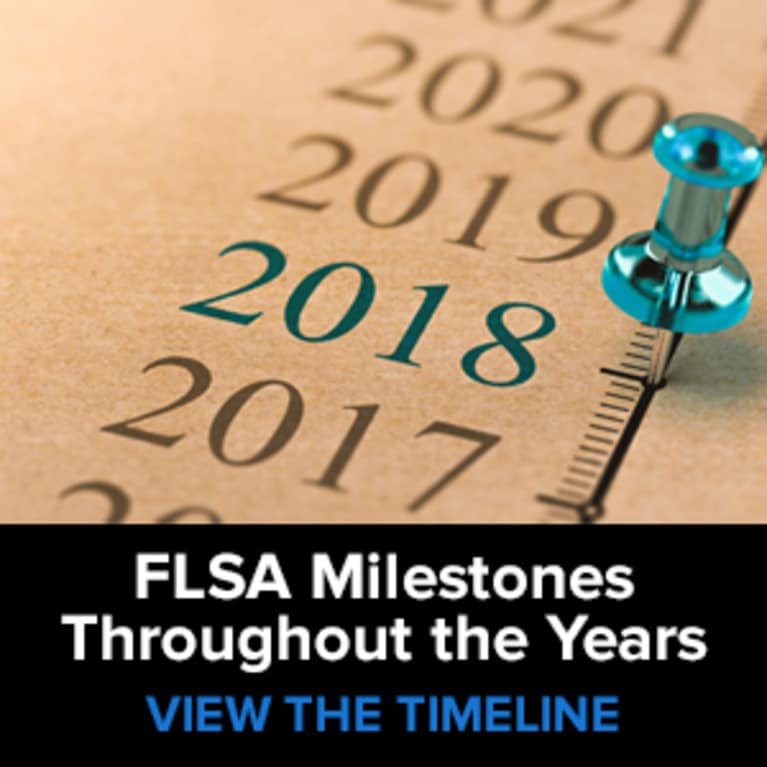

The Fair Labor Standards Act (FLSA) was enacted 80 years ago to improve working conditions in the United States. The law has evolved over the years, and more changes will come as businesses and workers adapt to the 21st century workplace.
Since its passage in 1938, the Fair Labor Standards Act has had—and continues to have—a remarkable impact upon the workplace through its requirements that employees be paid at least a minimum wage for all hours worked and overtime premium pay for hours in excess of 40 hours in a workweek, said Steven Pockrass, an attorney with Ogletree Deakins in Indianapolis, in an interview with SHRM Online.

The FLSA initially established a 25-cent hourly minimum wage (now $7.25) and a 44-hour workweek (which was later reduced to 40 hours). The act also banned businesses from employing workers younger than 14—with some exceptions for agricultural and family businesses—and limited the types of jobs children under age 18 could perform.
"What we have to celebrate about the FLSA is the basic principle it established: If you work, you should be paid," said David Weil, the Department of Labor's wage and hour division administrator under President Barack Obama, at a symposium at Georgetown University Law Center in March.
At the time the FLSA was enacted, it was a radical change for the government to set standards for private industry, said Richard Fiesta, executive director of the Alliance for Retired Americans in Washington, D.C.
In recent years, however, many state and local laws have become more generous than federal law. Employers need to understand—and comply with—all of the wage and hour laws that affect their workplace.
While lawsuits and regulatory actions over the FLSA are common today, that hasn't always been the case. "Despite its long history, the FLSA has not always been a hotbed for lawsuits," Pockrass said. "Today, however, the plaintiffs' employment bar actively pursues FLSA collective actions, which have become a major source of potential exposure for employers."
HR departments should adopt technology to aid in their wage and hour compliance efforts, noted LaToi Mayo, an attorney with Littler in Lexington, Ky. Compliance tools can help with payroll audits and determine employee classifications.
Mayo recommended that employers pay particular attention to:
Today, employees often can perform work wherever and whenever they have an Internet or mobile phone connection, Pockrass said. "Well-crafted policies, training and enforcement are key steps to compliance."
In addition, job duties often change over time, so employers need to be vigilant in determining whether such changes have an impact on a position's exemption status, he added.
Predicting the future activities of Congress is difficult in and of itself, so trying to predict what new laws Congress may pass to change the FLSA is even more challenging, Pockrass said.
As the economy continues to evolve, he hopes to see a hybrid "independent contractor/employee" status created to accommodate the gig economy. There are efforts underway to amend the FLSA to recognize an "independent employee" or "intermediary employee."
Worker advocates, however, aren't so welcoming of a hybrid contractor/employee status. Technology will continue to change how work is done, but the reality is that most people still are in conventional work arrangements, said Christine Owens at the symposium. She is the executive director of the National Employment Law Project (NELP) in Washington, D.C. NELP is concerned about creating an intermediary standard between employee and independent contractor because employers may misclassify workers who are actually employees and should have the associated employment protections, she said.
NELP does support sector-based standards, however, for industries in which there are many independent contractors or where there may be high rates of misclassification, such as in the ride-share industry. "We need to experiment with approaches like that, but keep the focus on ensuring that everyone who works in this country earns a decent living and has safe working conditions," Owens said.
Another likely change on the horizon is an increase to the FLSA's salary threshold for white-collar exemptions. In 2016, the Department of Labor issued proposed final regulations that would have increased the minimum salary level to $913 per week (from $455), but those regulatory changes were deemed invalid by a federal court.
The Society for Human Resource Management (SHRM) supports an update of the salary level but one that follows previous methodology to achieve a more equitable increase. SHRM said the 2016 rule's salary increase of over 100 percent was too far and too fast and would have presented particular challenges for employers whose salaries tend to be lower, such as small employers, nonprofits, employers in certain industries and employers in certain geographic regions of the country that tend to have lower costs of living.
"There seems to be widespread agreement that a less-drastic increase in the minimum salary level is warranted, but we don't know when new proposed regulations or final regulations will be issued, or how such regulations will fare in the courts," Pockrass said.
Was this article useful? SHRM offers thousands of tools, templates and other exclusive member benefits, including compliance updates, sample policies, HR expert advice, education discounts, a growing online member community and much more. Join/Renew Now and let SHRM help you work smarter.